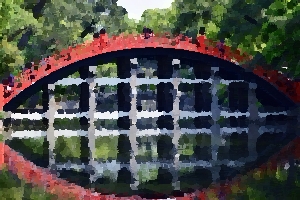What do seafaring, song, and peace have in common? Well, if you go and visit one of Osaka's famous shrines, you will see that these three qualities are encapsulated in the Sumiyoshi Taishi Shrine, which is dedicated to the patrons of the sea. Fishers, sailors, and travelers venerate this shrine and fervently pray for safe travel and protection for their vessels. Legend has it that the empress Jingo had the shrine built in 211 as an expression of thanksgiving for a safe journey to Korea.
This Shinto shrine is one of Japan's most popular, so much so that there are 2,000 so named shrines all over Japan. As with the original, these shrines are invariably built close to the docks so that sailors and travelers can readily visit and pay their respects to the gods guarding their vessels.
The original Sumiyoshi Taisha, located in Osaka, Japan, is the most important Sumiyoshi shrine. It is also one of the country's oldest shrines established in the 3rd century, way before Buddhism was introduced into the country. As such, the Sumiyoshi Taishi is an excellent example of pure Japanese shrine architecture, referred to as the sumiyoshi-zukiri. For its historical and architectural significance, the shrine has been declared a National Treasure.
 The Drum Bridge at the Sumiyoshi Taisha shrine. [CC] credit.
The Drum Bridge at the Sumiyoshi Taisha shrine. [CC] credit.On the way to the main hall, you get to go under the huge archway gate and past the arched bridge called the taiko bashi or drum bridge. It is so named because of the bridge and the reflection it makes on the pond below form the shape of a drum. This was built as a gift by Yodogimi, Toyotomi Hideyoshi's lover.
The main shrine is made up of four structures. The buildings feature thatched roofs and logs jutting out at different angles. The Main Hall presents a striking façade composed of red lead and gold fittings. Inside, you will see four enshrined deities – Jingu-Kogo, Nakatsutsuo-no-mikoto, Sokotsutsuo-no-mikoto and Uwatsutsuo-no-mikoto. The last three are gods and guardians of the sea and ensure one's safe travel and protection.
This shrine harks back to when Osaka was a major player in the maritime industry, being the main water highway for boats traveling east and west. Of course, years of development and reclamation resulted in the shrine being farther and farther away from the sea. However, fishers still visit the shrine to have their boats blessed. In fact, most of the stone lanterns that line the path leading to the shrine were donated by devout ship owners and sailors.
The Sumiyoshi Taisha shrine is also a favorite when it comes to New Year's wishes and prayers. Over three million people flock to the shrine during the first few days of the New Year to send their prayers to the gods for prosperity and protection.
The Sumiyoshi Taisha shrine, especially the drum bridge, plays host to some of the city's significant festivals. There is the Hattatsu-san, a festival praying for prosperity. The shrine is also the site for the Onda Shinji, a colorful rice-planting ceremony, where costumed women dance and pray for an abundant harvest. This festival is held in June and allows visitors to join in the dance performances and the singing of traditional Japanese songs. Locals believe that the music will enliven the soil, making it fertile and productive.
Meanwhile, the Sumiyoshi Matsuri celebrates the journey of a portable shrine (weighing 2 tons!). The parade starts from the shrine down to Yamato-gawa and back to Sumiyoshi Taisha. It is also accompanied by a street bazaar.
Visit this shrine and get caught up in the rich cultural heritage that is uniquely and proudly Japanese.